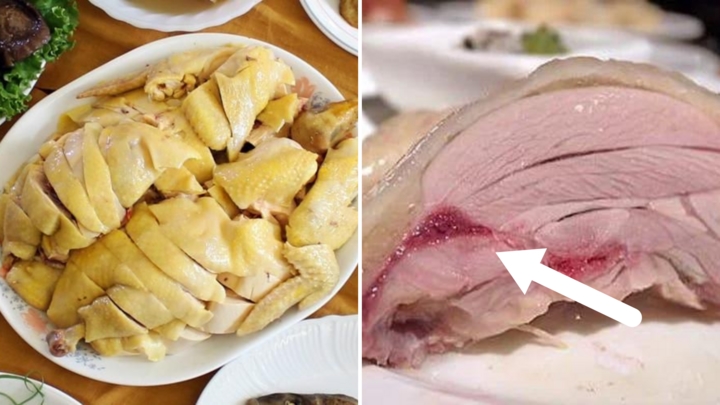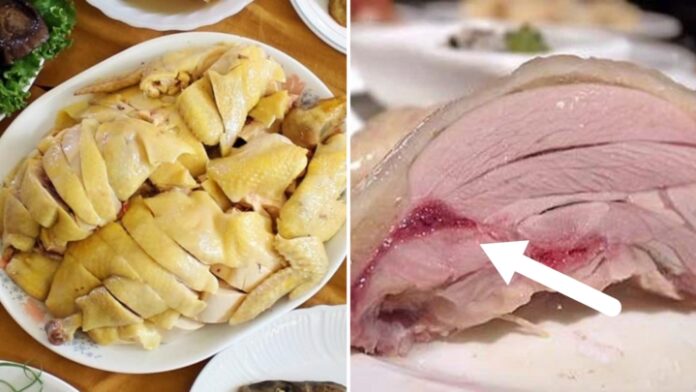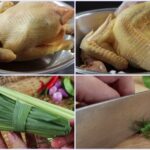Boiled chicken is a staple in traditional Vietnamese feasts and a beloved dish for many. It is the most preferred method of preparation.
Is a boiled chicken undercooked if the bone marrow is still red after cooking?
Not just for chicken but for all boiled meats in general, achieving the right doneness is crucial to ensuring the quality of the final product. Undercooking can result in raw meat, while overcooking leads to dry, tough meat. When boiling chicken, home cooks usually time it precisely to achieve the perfect doneness. However, even after sufficient boiling, the chicken meat near the bone marrow may still appear reddish-pink.
Is this a sign of undercooked chicken? Many believe that it indicates the chicken is raw and consuming it could lead to stomachaches and digestive issues. However, this is not always the case. Often, the chicken has been boiled long enough, and the meat is cooked, but the bone marrow and surrounding meat retain a reddish tint.
According to Dr. Greg Blonder, a physicist and author of several books on food, this phenomenon is entirely normal. The reddish-pink color in the chicken meat and even the reddish liquid that seeps out are not due to blood or raw bone marrow.
The color we observe is a result of myoglobin in the chicken bone marrow reacting with air during the cooking process. This reaction can cause some parts of the meat and bones to exhibit a reddish hue. The reddish-pink liquid that oozes out when the chicken is cut is also not chicken blood but a mixture of chicken juice and myoglobin.
Instead of relying on the color of the bone marrow to determine if the chicken is cooked, you should use a different method. Employ a food thermometer to measure the temperature at the deepest part of the inner thigh, wings, and the thickest part of the breast. According to the United States Department of Agriculture (USDA), all parts of the chicken meat should reach a minimum internal temperature of approximately 165 degrees Fahrenheit to be considered safely cooked.

Is the chicken undercooked if the bone marrow is still red after boiling? Not necessarily; sometimes, the chicken is thoroughly cooked, but the bone marrow and nearby meat retain a reddish color. (Photo: Pinterest)
How to Prevent the Chicken Bones from Turning Red
Now that you know that reddish bone marrow doesn’t necessarily indicate undercooked chicken, you may want to prevent this occurrence. To do so, alter the pH level of the boiling water by adding a bit of vinegar or lemon juice. When preparing the chicken, rub it with lemon and coarse salt; this will effectively remove any odors and reduce the chances of red bones.
Another tip is to marinate the chicken with a small amount of lemon juice or vinegar. This not only helps crisp the skin but also prevents myoglobin from changing color when exposed to air during boiling.
Tips for Boiling Chicken to Perfection
The best chicken for boiling is free-range or backyard-raised chicken. When buying live chicken, choose healthy birds with shiny, bright feathers. If purchasing pre-slaughtered chicken, opt for those with a natural light yellow skin that feels firm to the touch, with a small crop, and minimal fat around the neck and thighs.
After buying pre-slaughtered chicken, rub it with lemon and salt, then rinse it under running water to remove any dirt. Place the chicken in a pot of cold water and bring it to a boil over medium heat, allowing the meat to cook gradually from the outside in. Do not wait for the water to boil before adding the chicken, as this will result in uneven cooking and cracked skin. If using frozen chicken, ensure it is completely thawed before boiling.
Use a pot that is just big enough for the chicken. A pot that is too large wastes space and time, while a small pot may lead to uneven cooking.
Some additional tips for boiling chicken:
– Position the chicken’s belly downward and add enough water to completely submerge it.
– After the water has boiled for about 5 minutes, reduce the heat to a gentle boil for another 5 minutes, then turn off the heat. Cover the pot and let the chicken rest for an additional 20 minutes. For larger chickens or game birds, you may consider cooking for a few extra minutes before turning off the heat to ensure tenderness.
– Use a pair of chopsticks to poke the chicken to check for doneness. If the chopsticks can easily penetrate the meat, and the juices run clear, the chicken is cooked.
To ensure the boiled chicken has a vibrant, plump skin, immediately immerse it in a pot of cooled boiled water after removing it from the cooking pot; cold water is even better. Then, pat the chicken dry and mix fresh turmeric juice with some of the chicken’s fried fat, brushing this mixture over the chicken’s skin.
According to VTC News
The Perfect Poached Chicken: A Simple Trick for Golden, Tender Meat
“Boiled chicken has long been a staple in Vietnamese cuisine, not only as an everyday dish but also as a must-have during festive occasions and ancestral worship ceremonies. However, not everyone knows how to boil chicken to perfection – with intact skin, no redness in the meat, and especially, that delightful crunchy texture.”
The Ultimate Guide to a Perfectly Golden Chicken: A Leafy Hack.
In the realm of traditional Vietnamese cuisine, every dish is a precious remedy, and each ingredient is combined with purpose. The humble boiled chicken, a staple in many households, is always accompanied by lime leaves, creating a harmonious blend of flavors that not only delights the taste buds but also offers a plethora of health benefits.








































